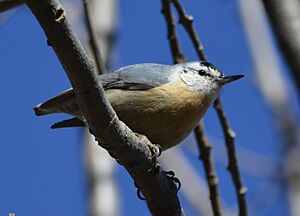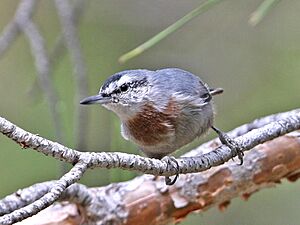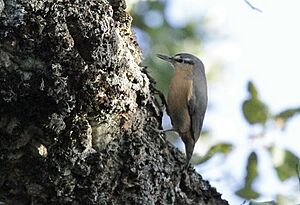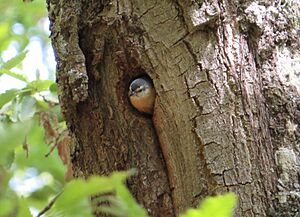Algerian nuthatch facts for kids
Quick facts for kids Algerian/Kabyle nuthatch |
|
|---|---|
 |
|
| Conservation status | |
| Scientific classification | |
| Genus: |
Sitta
|
| Species: |
ledanti
|
 |
|
| Distribution map showing the forests used by the nuthatch in red | |
The Algerian nuthatch or Kabyle nuthatch (Sitta ledanti) is a special bird from the nuthatch family, called Sittidae. It's a medium-sized bird, about 11.5 cm (4.5 in) to 12.5 cm (4.9 in) long. Its back is a pretty bluish-gray color.
You can tell the male and female apart by their heads. Males have a black patch on the front of their crown. These birds don't migrate; they stay in the same place all year. They eat arthropods (like insects and spiders) in summer and seeds in winter. They usually lay three or four eggs in a tree hole around May or June. The female sits on the eggs, and both parents help feed the baby birds.
The Kabyle nuthatch is the only bird that lives only in Algeria. It can only be found in certain pine and fir forests in the northern part of the country. Its scientific name honors Jean-Paul Ledant, a Belgian nature lover who found the bird in 1975. The news of this discovery was a big surprise to bird experts worldwide! This nuthatch is very similar to Krüper's nuthatch. Sadly, its home is shrinking because of fires, erosion, and human activities. Because of this, the International Union for Conservation of Nature says it is an "endangered" bird.
Contents
What Does the Algerian Nuthatch Look Like?
The Algerian or Kabyle nuthatch is a medium-sized bird. It's about 11.5 cm (4.5 in) to 12.5 cm (4.9 in) long and weighs around 18 grams (0.63 oz). Its upperparts (back and wings) are bluish-gray. The tail has a small white band near the end. Its belly is a light salmon-beige color.
Male birds have a black forehead and a dark stripe through their eye. A bright white stripe above the eye separates this from the gray crown. Females have a gray crown and eye stripe, similar to their back. Sometimes, the front of a female's crown can be a bit darker, but never as dark as a male's. Both males and females have white cheeks and throats. Their eyes are dark brown, legs are gray, and the bill (beak) is bluish-gray. Young birds look like females but are duller.
It's hard to confuse the Kabyle nuthatch with other birds in its area. The Eurasian nuthatch lives nearby but is larger. It also doesn't have black on its crown and has yellow or white underparts. The Kabyle nuthatch looks a lot like the Corsican nuthatch. However, the male Corsican nuthatch has a black crown that covers its whole head, not just the front. The Algerian nuthatch also has warmer pinkish-buff underparts. It is very closely related to Krüper's nuthatch. Krüper's nuthatch also has a dark front to its crown and a white stripe above the eye. But it has pale gray underparts and a large reddish-brown patch on its chest.
How Was This Bird Discovered?
Finding a New Species
The Algerian/Kabyle nuthatch was first found in Algeria by Jean-Paul Ledant, a Belgian nature expert, on October 5, 1975. He realized it was different from other nuthatches. He wrote to the Academy of Sciences to share his exciting discovery. Experts encouraged him to go back to the area.
Ledant later returned with Jacques Vielliard in April 1976. They wanted to study the birds nesting. They had to wait until July to see the young birds and how the parents fed them. They also made recordings of their calls. Vielliard collected two adult birds to study them closely. These birds became the "type specimens" for the species. This discovery was a huge surprise because a new bird species had not been found in the Mediterranean area for almost 100 years!
In December 1976, another bird expert, Eric Burnier, said he had also found the species on his own. He saw birds that looked like a mix of Corsican and Krüper's nuthatches. Since the only known nuthatch in North Africa was the Eurasian nuthatch, he knew he had found something new.
Family Tree of the Nuthatch

The Algerian/Kabyle nuthatch belongs to a group called Micrositta. It doesn't have any different types or "subspecies." Scientists have studied the DNA of different nuthatch species. They found that the Corsican nuthatch, Chinese nuthatch, and red-breasted nuthatch are closely related. These three are like sisters to a group that includes Krüper's nuthatch and the Algerian/Kabyle nuthatch.
This means that the Algerian nuthatch and Krüper's nuthatch are very close relatives. They both have a black patch on the front of the male's crown. This black patch is not seen in young birds.
Here's a simple family tree showing how these nuthatches are related:
|
Scientists believe these nuthatches once lived in a continuous belt of conifers (trees like pines and firs) around the Mediterranean Sea. Over time, this forest broke into smaller pieces. This caused the different nuthatch species to become isolated and evolve separately. The Algerian nuthatch and Krüper's nuthatch split into two different species about 1.75 million years ago.
How Do Algerian Nuthatches Live?
Sounds They Make
The Algerian nuthatch makes a typical nuthatch call, which sounds like tsiit tsiit. Adults might also make a quiet call if an intruder is nearby, perhaps to protect their territory. Their song is a nasal whistle, a series of rising sounds with a short end note. It can be written as vuuy-di vuuy-di vuuy-di. This song is repeated slowly, usually seven to twelve times, and lasts for two to four seconds. They can also make a fast trill sound like di-du-di-du-di-du. When they are upset, they make a harsh, repeated chèèh sound, similar to a jay.
What They Eat
Scientists haven't studied the Algerian nuthatch's diet a lot. What they eat changes with the seasons. In summer, they mostly eat insects like caterpillars and beetles, and also spiders. They find these by searching on the trunks and branches of oak trees. In winter, insects are harder to find. So, the Algerian nuthatch eats seeds from pine and fir trees, which are always available. They usually feed alone. But outside of the breeding season, they might join mixed groups of birds to find food.
Raising Their Young
The breeding season is from May to June. It can start earlier or later depending on the weather conditions and how much food is available. The nest is built inside a hole in a tree. This might be an old hole made by a great spotted woodpecker. They use dead fir trees or rough spots in oak or cedar trees. The nest is usually 4–15 m (13–49 ft) off the ground. The bottom of the nest is lined with plant bits like wood chips and leaves. They also use animal materials like tawny owl feathers or wild boar hair.
Only the female sits on the eggs to keep them warm. But both parents help feed the young birds. They usually have three or four young birds in a clutch. After the breeding season, adult birds grow new feathers. Young birds also grow some new feathers.
Where Do Algerian Nuthatches Live?
The Algerian/Kabyle nuthatch is the only bird that lives only in Algeria. It lives in certain parts of Kabylia. It has been found in five different places. These places are separated by areas where the nuthatch cannot survive. It was first found on Mount Babor. This area is only about 20 km2 (7.7 sq mi) from the Mediterranean coast. Only about 80 pairs lived there in 1985.
Later, in June 1989, it was found in Guerrouch, inside the Taza National Park. This park has a larger population of about 350 birds. Smaller groups were found in 1990 in Tamentout and Djimla. In 2018, a new breeding spot was found in Ghabet Ezzen. About twenty birds were seen and photographed there. The bird might live in other oak forests in Petite Kabylie, but this has not been confirmed yet.
The Algerian/Kabyle nuthatch lives in oak forests between 350 m (14,000 in) and 1,120 m (44,000 in) high. It also lives in mixed forests of oak, maple, poplar, and conifer trees at 2,000 m (79,000 in) altitude. They like humid forests with large trees that have holes for nesting. These trees include the Algerian fir, Atlas cedar, Afares oak, cork oak, and Portuguese oak. Mount Babor has a cool, humid climate with snow in winter. Guerrouch is warmer and drier, with more oak trees.
Studies show that the nuthatch likes forests with many different types of trees. It also prefers large, old trees. The climate at higher altitudes seems to be good for them too.
Why Are Algerian Nuthatches Endangered?
How Many Are Left?
When the Algerian/Kabyle nuthatch was first found, experts thought there were only about a dozen pairs. They worried that people might try to collect them, causing them to disappear. But finding the larger group in Taza National Park in 1989 showed that the bird was not as rare as first thought. It also showed that it didn't just live on Mount Babor.
The nuthatch's current home seems limited by where its forests are. The fact that the groups are separated might mean the bird used to live in a much larger area. But deforestation (when forests are cut down) isolated them into the small "islands" of forest they live in today. The Algerian/Kabyle nuthatch has a small population. There might be fewer than 1,000 birds in total. Scientists estimate there are between 350 and 1,500 individuals. Although there are no exact numbers, these numbers are believed to be decreasing. This is because their habitat is shrinking. The International Union for Conservation of Nature has listed the Algerian nuthatch as "endangered" since 1994.
What Are the Threats?
The biggest danger to the Algerian/Kabyle nuthatch is the destruction of its home. Fires are a major problem. They burn the old mixed forests on Mount Babor. These forests are then replaced by poorer plants, mostly cedars. Cows grazing and illegal logging (cutting down trees) are also threats. This happens even in Taza National Park. Building a road in the 1970s caused soil erosion and increased fire risk. Even fighting terrorism in the region can disturb the birds. The Algerian/Kabyle nuthatch also has predators that might eat its eggs or young. These include the least weasel, the garden dormouse, or the great spotted woodpecker.
How Are They Protected?
The Algerian nuthatch is a protected species in Algeria. It is one of 32 animal species listed as protected by a law from 1983. In 1980, BirdLife International asked the U.S. federal government to add 60 foreign species, including the Algerian/Kabyle nuthatch, to their endangered lists. This request was made official in 1981. These species were finally added to the endangered species lists in 1995.
The largest group of these birds lives in a protected area, the Taza National Park. To help save the species, it's important to learn more about how many birds there are and what they need to survive. However, some protection steps are already being taken. These include restoring their habitat and preventing fires. Planting trees for firewood outside of existing forests also helps. The Algerian/Kabyle nuthatch is a flagship species. This means protecting it helps protect the entire Babor Mountains forest.





